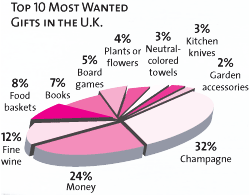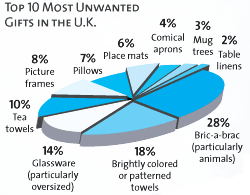
 For all but royalty, weddings were once modest affairs; now they are a $50 billion annual industry.
For all but royalty, weddings were once modest affairs; now they are a $50 billion annual industry.
According to the GAO, there are 1,138 federal statutes in which marital status factors into benefits and rights.
The average American wedding costs $22,360 and has 168 guests, who give 100 gifts that cost an average of $85 each, meaning the net loss to the couple is $13,860.
The average guest spends $500 to attend a wedding—not including plane tickets.
Bush’s proposed “Healthy Marriage Initiative” would spend $1.5 billion to promote marriage among the poor.
An increase of $1 per hour in a man’s wages increases the odds he will marry by 5%.
40% of all guests now fly to weddings, more than 60% of which entail at least two days’ worth of events.
43% of couples say they spent more on their wedding
than they had planned.
ln 2001, Washington, D.C., Alabama, and Michigan each received
a $25 million federal “illegitimacy bonus” for reducing rates of children born to unmarried parents while keeping abortion rates flat. The illegitimacy rates were reduced by 4%, 0.25%, and 0.0009%, respectively.
43% of first marriages end within 15 years.
The cost of the average American wedding has been steadily climbing.
Red states have a divorce rate 27% higher than blue states.
24 states have laws against adultery.
61% of couples omit the word “obey” from their vows, but 83% of brides take their husband’s name.
It was only in 1967 that the Supreme Court invalidated state
laws prohibiting people of different races from marrying.

On either side of the Atlantic, some gifts are jolly good, while others are just bollocks.

If the average amount spent on a wedding were invested at a 10% annual return rate, it would pay for the expected private college tuition of an infant.
Cultural conservatives may abhor gay marriage, but not so wedding-related businesses, which, Forbes magazine forecasts, can expect a $17 billion windfall from gay unions.
Couples who marry in a Disney World “Fairy
Tale Wedding”™ can tie the knot in an array of ersatz locales, including Animal Kingdom or Oz. For $2,500 a bride can arrive in a glass coach pulled by four dappled gray ponies.
There are at least 27 wedding reality TV shows, including
Whose Wedding Is It Anyway?
Only 38% of wedded Americans say they are “happily married.”
Nearly half of all U.S. nuptials involve at least one remarriage. Liza Minnelli’s 4th wedding cost $7,000 for each day the marriage lasted.
75% of all divorced people remarry, half of them within three years.
|
Ojani Noa* |
Yes, but “I don’t want to talk about it,” says Noa. |
He proposed at Selena wrap party. |
|
Sean Combs |
J-Lo gave Puffy diamond-studded pinkie ring |
Puffy accused of using ring to bribe driver to take rap for an illegal gun. |
|
Cris Judd* |
4-carat |
Met on Love Don’t Cost a Thing set. He got $15 million in divorce. |
|
Ben Affleck |
6-carat, $1.2 million |
Knockoffs sell for $19.95 |
|
Marc Anthony* |
8-carat |
J-Lo wore 198 carats at wedding. |
|
*actually married |
||
Up to 20% of couples use a prenuptial agreement, including Catherine Zeta-Jones, who, were she and Michael Douglas to divorce, would reportedly get $2.8 million for each year of marriage. Their wedding cost between $1.5 and $2 million—offset by selling exclusive photos of the ceremony to Britain’s OK! magazine for $1.6 million, and a $24,000 judgment against Hello!
magazine for running unapproved photos.
Founded in 1888 by Cecil Rhodes, De Beers has three operating principles: control supply, raise prices, and sell the romance of rarity.
|
De Beers hires N.W. Ayer and Co. to make diamonds “a psychological necessity…the larger and finer the diamond, the greater the expression of love.” Within three years, 80% of engagements are consecrated with a diamond ring. |
After a sociologist advises diamonds be presented as a symbol of a man’s ability to “get into the competitive race,” N.W. Ayer begins loaning gems to actresses, “who can make the grocer’s wife say, ‘I wish I had what she has.’” |
Department of Justice charges De Beers with “conspiring to restrict production, monopolize sales and arbitrarily influence prices” by cornering 95% of world market. De Beers executives fail to show up in court, pull company out of U.S. market, opting to use middlemen. |
|||
|
“A Diamond Is Forever” slogan debuts. Jewelers instructed to tell men—who buy 90% of all diamonds—to spend at least two months’ salary on ring. The not-so-subtle message: Can you afford not to? |
De Beers gains control of huge Soviet cache of small stones and begins emphasizing “color, cut, and clarity.” |
Thanks to 14-year campaign to glamorize Western wedding customs, 60% of Japanese wives sport diamond rings; their husbands spend more on them than American counterparts. |
|||
|
DOJ again charges De Beers with price-fixing. Executives again skip court and can’t visit the U.S. for fear of arrest. |
Advertising Age declares “A Diamond is Forever” the most effective slogan of 20th century, recognized by 90% of Americans. |
“Three-stone anniversary ring” campaign is an instant success. |
|||
|
“Diamonds that make a statement”—i.e., they’re bigger— campaign aimed at affluent married couples. Uses slogans like: “Thank you, Bob… Thank you, Lord.” |
De Beers markets “right-hand ring” to “stylish” and “independent” single women. Uses slogan, “Your left hand says ‘we,’ your right hand says ‘me.’” |
De Beers pays $10 million antitrust penalty, clearing way to open stores in the U.S. It now controls 60% of world market. |
|||
 Taking the Plunge? Or a Ceremonial Bath?
Taking the Plunge? Or a Ceremonial Bath?










